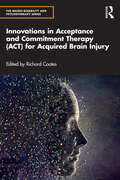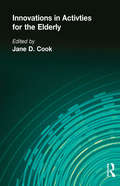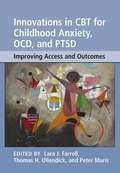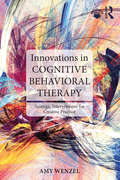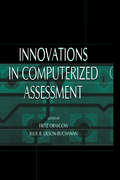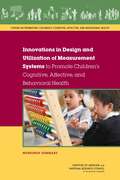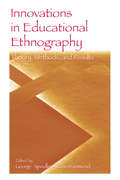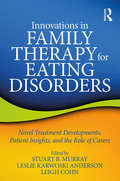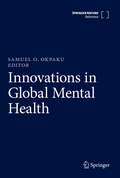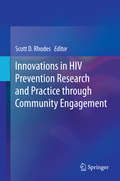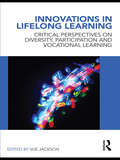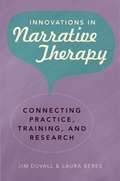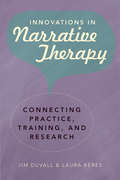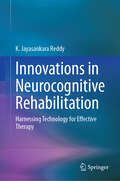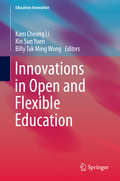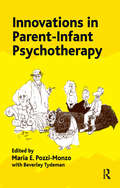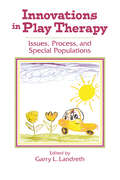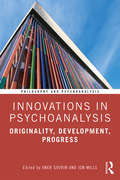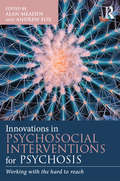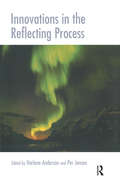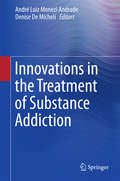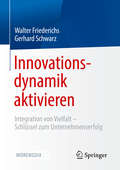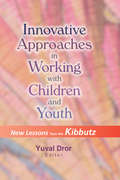- Table View
- List View
Innovations in Acceptance and Commitment Therapy (The Neuro-Disability and Psychotherapy Series)
by Richard CoatesAcceptance and Commitment Therapy (ACT) allows people with acquired brain injury to develop psychological flexibility, in order to lead a vital life, despite all the difficult thoughts, feelings and brain injury symptoms that are present.Innovations in Acceptance and Commitment Therapy (ACT) for Acquired Brain Injury brings together contributions from highly experienced clinicians, using innovative approaches in ACT for acquired brain injury, in the context of individuals, working with relatives, groups and multidisciplinary teams.This book will be a valuable resource for clinical psychologists, clinical neuropsychologists, counselling psychologists, cognitive behaviour therapists, psychiatrists and counsellors working therapeutically with clients with acquired brain injury.
Innovations in Activities for the Elderly: Proceedings of the National Association of Activity Professionals Convention
by David CookConcrete directions for programming and reasons for developing and refining such programs.
Innovations in Behavioural Health Architecture
by Stephen VerderberInnovations in Behavioural Health Architecture is the most comprehensive book written on this topic in more than 40 years. It examines the ways in which healthcare architecture can contribute, as a highly valued informational and reference source, to the provision of psychiatric and addictive disorder treatment in communities around the world. It provides an overview of the need for a new generation of progressively planned and designed treatment centres – both inpatient and outpatient care environments – and the advantages, challenges, and opportunities associated with meeting the burgeoning need for treatment settings of this type. Additional chapters address the specifics of geriatric psychiatry and its architectural ramifications in light of the rapid aging of societies globally and provide a comprehensive compendium of planning and design considerations for these places in both inpatient and outpatient care contexts. Finally, the book presents an expansive and fully illustrated set of international case studies that express state-of-the-art advancements in architecture for behavioural healthcare.
Innovations in CBT for Childhood Anxiety, OCD, and PTSD: Improving Access and Outcomes
by Thomas H. Ollendick Lara J. Farrell Peter MurisChildhood anxiety, obsessive-compulsive disorder (OCD) and post-traumatic stress disorder (PTSD) represent some of the most common mental health disorders affecting young people, often leading to major life impairments. This book brings together the world's leaders in treatment science to provide evidence-based psychosocial interventions for these disorders. It supplies practitioners and researchers with innovations in clinical science, highlighting advances in technology and neuroscientific discovery which have informed the development of these novel treatment advances. The authors tackle the two main challenges facing the field of childhood psychopathology: improving access to evidence-based cognitive behavioural therapy (CBT) through innovations in treatment delivery, and increasing the positive outcomes for youth through unique therapies. Any reader who wants to be informed on the latest approaches to cognitive and behavioural interventions and how to apply them will benefit from this book.
Innovations in Cognitive Behavioral Therapy: Strategic Interventions for Creative Practice
by Amy WenzelInnovations in Cognitive Behavioral Therapy provides clinicians with a powerful arsenal of contemporary, creative, and innovative strategic interventions for use in cognitive behavioral therapy (CBT). This book goes well beyond standard CBT texts by highlighting new developments in the field and advancing a new definition of CBT that reflects the field’s evolution. Throughout these pages, clinicians will find empirical research to back up recommended strategies and discussion of ways to translate this research into their clinical practice. Readers can also turn to the book’s website for valuable handouts, worksheets, and other downloadable tools.
Innovations in Computerized Assessment
by Fritz Drasgow Julie B. Olson-BuchananComputerized assessment offers many opportunities for innovations in measurement. In contrast to static paper-and-pencil instruments, computerized assessment can capitalize on the dynamic capabilities of the computer. For example, the difficulty of administered items can be adopted to the ability of the examinee, thus eliminating items that are too hard or too easy. Multimedia computers provide the opportunity to revolutionize assessment. Stereo sound, animation, and full-motion video can be incorporated into assessment tools and aid in the measurement of individual differences ranging from musical skills to interpersonal abilities. Innovations in Computerized Assessment presents the experiences of leading researchers in computerized assessment. The book places particular emphasis on the dilemmas that were faced by the researchers. Questions addressed include: * What problems did they confront? * What were the pros and cons of various options? * How were dilemmas resolved? * Were the solutions good ones?
Innovations in Design and Utilization of Measurement Systems to Promote Children's Cognitive, Affective, and Behavioral Health: Workshop Summary
by Steve OlsonMany measurement systems to monitor the well-being of children and guide services are implemented across the community, state, and national levels in the United States. While great progress has been made in recent years in developing interventions that have been shown to improve the cognitive, affective, and behavioral health of children, many of these tested and effective interventions have yet to be widely implemented. One potential reason for this lag in implementation is a need to further develop and better utilize measures that gauge the success of evidence-based programs as part of a broad effort to prevent negative outcomes and foster children's health and well-being. To address this issue, the Institute of Medicine Forum on Promoting Children's Cognitive, Affective, and Behavioral Health held a workshop in Washington, DC, on November 5-6, 2014. The workshop featured presentations on the use of data linkage and integration to inform research and practice related to children's cognitive, affective, and behavioral health; the use of quality measures to facilitate system change in health care, classroom, and juvenile justice settings; and tools developed to measure implementation of evidence-based prevention programs at scale to support sustainable program delivery, among other topics. Workshop presenters and participants discussed examples of innovative design and utilization of measurement systems, new approaches to build on existing data systems, and new data systems that could support the cognitive, affective, and behavioral health and well-being of children. This report summarizes the presentation and discussions of the event.
Innovations in Educational Ethnography: Theories, Methods, and Results
by George Spindler Lorie HammondThis volume focuses on and exemplifies how ethnography--a research tool devoted to looking at human interaction as a cultural process rather than individual psychology--can shed light on educational processes framed by the complex, internationalized societies in which we live today. Part I offers theoretical chapters about ethnography and examples of innovative ethnography from particular perspectives. In Part II, the emphasis is on the application of ethnographic approaches to educational settings.Each contribution not only takes the reader on a thoughtful and enlightening journey, but raises issues that are important to both educators and ethnographers, including the relationship of researcher to subject, the meaning of "participant" in participant observation, and ways to give voice to disenfranchised players, and on the complex ways in which all parties experience identities such as "race" in the modern world.Innovations in Educational Ethnography: Theory, Methods, and Results is a product of both continuity and change. It presents current writings from mentors in the field of ethnography and education, as well of the work of their students, and of educators engaged in cultural studies of their work. In many ways it provides fresh, new vistas on the old questions that have always guided ethnographic research, and can be used as a survey both of what ethnography has been and what it is becoming.This book is the work of many hands, and provides excellent examples of trends in both basic and applied ethnography of education. These two kinds of work augment and reinforce each other, and also represent important current research directions--in-depth reflection on the process of ethnography itself, and an application of its insights to teaching and learning in schools, universities, and communities. No one philosophy guides the contributions to this volume, nor were they chosen as exemplary of a particular approach, yet foundational understandings and principles of ethnography shine through the work, in both predictable and unexpected ways.
Innovations in Family Therapy for Eating Disorders: Novel Treatment Developments, Patient Insights, and the Role of Carers
by Stuart Murray Leigh Cohn Leslie AndersonInnovations in Family Therapy for Eating Disorders brings together the voices of the most-esteemed, international experts to present conceptual advances, preliminary data, and patient perspectives on family-based treatments for eating disorders. This innovative volume is based partly on a special issue of Eating Disorders: The Journal of Treatment and Prevention and includes a section on the needs of carers and couples, "Tales from the Trenches," and qualitative studies of patient, parent, and carer experiences. Cutting edge and practical, this compendium will appeal to clinicians and researchers involved in the treatment of eating disorders.
Innovations in Global Mental Health
by Samuel O. OkpakuOver the course of the last decade, political and mental entities at large have embraced global mental health: the idea that psychiatric health is vital to improved quality of life. Physicians globally have implemented guidelines recommended by the National Institute of Mental Health (NIMH) in 2007, thereby breaking down barriers to care and improving quality of life in areas where these practices have been implemented. Programs for training and education have expanded as a result. Clinicians benefit more from both local resources in some regions as well as in international collaboration and technological advancements. Even amidst all of these positive outcomes, clinicians still face some stumbling blocks. With worldwide statistics estimating that 450 million people struggle with mental, neuropsychiatric, and neurological disorders—25 percent of the world’s non-communicable disease burden—rising to these challenges prove to be no small feat, even in wealthy Western nations. Various articles and books have been published on global mental health, but few of them thoroughly cover the clinical, research, innovative, and social implications as they pertain to psychiatry; often, only one of these aspects is covered. A comprehensive text that can keep pace with the rapidly evolving literature grows more and more valuable each day as clinicians struggle to piece together the changes around the world that leave open the possibility for improved outcomes in care. This book seeks to boldly rectify this situation by identifying innovative models of service delivery, training, education, research funding, and payment systems that have proven to be exemplary in implementation and scalability or have potential for scalability. Chapters describe specific barriers and challenges, illuminating effective strategies for improved outcomes. This text is the first peer-reviewed resource to gather prestigious physicians in global mental health from around the world and disseminate their expertise in the medical community at large in a format that is updateable, making it a truly cutting-edge resource in a world constantly changed by medical, scientific, and technological advances. Innovations in Global Mental Health is the ultimate resource for psychiatrists, psychologists, primary care physicians, hospitalists, policy makers, and all medical professionals at the forefront of global mental health and its implications for the future.
Innovations in HIV Prevention Research and Practice through Community Engagement
by Scott D. RhodesHIV continues to be a profound challenge facing communities nationally and internationally. Until a vaccine or a cure is found, prevention remains a most crucial line of defense. However, the successes made to reduce exposure and transmission have not benefited all communities equally. HIV continues to affect vulnerable communities, and HIV-related health disparities are growing. The work documented in Innovations in HIV Prevention Research and Practice through Community Engagement spotlights the effectiveness of community involvement to reduce HIV infections in the United States. This timely resource introduces the concepts of community engagement, partnership, and community-based participatory research (CBPR). Contributors provide detailed examples of these concepts in which diverse research partners blend their unique insights and skills to arrive at an authentic understanding of phenomena and inform the translation of best practices and processes to enhance equity in HIV prevention and treatment. Equitable interactive collaboration is central to these efforts, in which community members and representatives from organizations, the scientific and medical sectors, and other relevant agencies nurture long-term health improvement through sustained teamwork. Challenges and barriers to effective engagement are identified, as are characteristics of successful partnerships. Included in the book: Details of a multigenerational HIV prevention intervention in a rural southeastern community. The challenges and successes of developing, implementing, and evaluating an intervention for higher-risk predominately heterosexual black men in college. The history of gay community involvement in HIV prevention and its contributions to the theory and current practice of engagement. Next steps in the integration of HIV-related policy change and research. Community engagement within American Indian communities. Keys to sustaining a CBPR partnership to prevent HIV within ethnic, sexual, and gender minority communities. Innovations in HIV Prevention Research and Practice through Community Engagement offers researchers and practitioners in public health, community health, and medicine guidance on community engagement that is both inspiring and realistic. "Community engagement and knowledge continue to be essential to prevent HIV infections. This book is a compilation of the state-of-the-science of engagement and delves deeper into the meaning and utilization of community-based participatory research, with implications that reach beyond the HIV epidemic to public health and medicine in general. " - Laura C. Leviton, PhD, Senior Advisor for Evaluation, Robert Wood Johnson Foundation, Princeton, NJ
Innovations in Interventions to Address Intimate Partner Violence: Research and Practice
by Tod Augusta-Scott Katreena Scott Leslie M. TuttyInnovations in Interventions to Address Intimate Partner Violence: Research and Practice speaks to what can be done to effectively intervene to end intimate partner violence against women. Including contributions from both researchers and practitioners, chapters describe service innovations across systems in large urban and remote rural contexts, aimed at majority and minority populations, and that utilize a range of theoretical perspectives to understand and promote change in violence and victimization. Reflecting this range, contributions to this volume are organized into five sections: legal responses to domestic violence, intervention with men who have perpetrated domestic violence, responses to women who have experienced domestic violence, restorative approaches to intimate partner violence, and a section on integrating intervention for domestic violence across systems. The book highlights advances in practice which will be of interest to researchers, practitioners, policy makers and students.
Innovations in Lifelong Learning: Critical Perspectives on Diversity, Participation and Vocational Learning
by Sue JacksonThis book opens up ways to engage critically with what counts as innovatory practice in lifelong learning today, locating its discussion of innovations in lifelong learning within an international and comparative framework. Innovations in Lifelong Learning engages first hand with issues and concerns from around the globe, offering an international perspective on current trends through its range of contributions from across the UK, Australia, New Zealand and the US. The broad focus allows for diverse information on the nature of these changes to come together under an assortment of empirical, theoretical and methodological approaches. The book takes three key elements of lifelong learning: learning communities participation and non-participation work-based learning and learning through work. It links these with themes on diversity, social justice and economic and global development so as to negotiate and re-negotiate the constant importance of innovation with employers, learners and educational institutions. All those working in the broad arena of lifelong learning will benefit from this comprehensive examination of current debates in the field, including policy-makers, researchers, teachers, lecturers, educational managers and employers engaged with work-based learning.
Innovations in Narrative Therapy: Connecting Practice, Training, and Research
by Jim Duvall Laura BéresNarrative therapy introduces the idea that our lives are made up of multiple events that can be strung together in many possible stories. These stories can be developed to find richer (or "thicker") narratives, and thus release the hold of negative ("thin") narratives upon the client. Replete with case examples from clinical practice, this is the first book to present a compelling evidence base for narrative therapy, interweaving practice tips, training, and research. The book's rigorous, research-based approach meets the increasing demand on therapists to demonstrate the effectiveness of their approach, critically reflecting on both process and outcomes, expanding on the concept of evidence-based practice.
Innovations in Narrative Therapy: Connecting Practice, Training, and Research
by Jim Duvall Laura BéresPresenting a compelling evidence base for narrative therapy. Narrative therapy introduces the idea that our lives are made up of multiple events that can be strung together in many possible stories. These stories can be developed to find richer (or "thicker") narratives, and thus release the hold of negative ("thin") narratives upon the client. Replete with case examples from clinical practice, this is the first book to present a compelling evidence base for narrative therapy, interweaving practice tips, training, and research. The book's rigorous, research-based approach meets the increasing demand on therapists to demonstrate the effectiveness of their approach, critically reflecting on both process and outcomes, expanding on the concept of evidence-based practice.
Innovations in Neurocognitive Rehabilitation: Harnessing Technology for Effective Therapy
by K. Jayasankara ReddyNeurocognitive disorders, such as Alzheimer's disease, stroke, and traumatic brain injuries, have a significant global impact, causing significant challenges for healthcare systems and families. Traditional rehabilitation methods often do not effectively target the diverse and complex cognitive impairments associated with these illnesses. Technology facilitates personalized rehabilitation approaches, enhances patient engagement, and enables unbiased evaluations of progress. This book is particularly pertinent in an era of rapid technological advancement, as it presents exceptional opportunities to revolutionize neurorehabilitation techniques and improve patient outcomes.
Innovations in Open and Flexible Education (Education Innovation Series)
by Kam Cheong Li Kin Sun Yuen Billy Tak WongThis book covers a broad range of innovations in education, such as flipped classrooms, the educational use of social media, mobile learning, educational resources and massive open online courses, as well as theoretical discussions and practical applications in the use of augmented reality and educational technology to improve student engagement and pave the way for students’ future studies and careers. The case studies and practical applications presented here illustrate the effectiveness of new modes of education in which the latest technologies and innovations are widely used in the global context. Accordingly, the book can help develop readers’ awareness of the potential these innovations hold, thus expanding their expertise and stimulating critical thinking as to how new technologies have made learning and teaching easier in various educational settings.
Innovations in Parent-Infant Psychotherapy: International Contributions
by Maria E. Pozzi-Monzo Beverley TydemanThis book has emerged from the authors' excitement about the proliferation of parent-infant psychotherapy work around the world, including Australia, Brazil, Europe, South Africa and the United States. It shows how the therapy connects with the culture of the family inspired by the wider community.
Innovations in Play Therapy
by Garry L. LandrethThis book is unique in exploring the process of conducting short-term intensive group play therapy and the subsequent results. It focuses on play therapy with special populations of aggressive acting-out children, autistic children, chronically ill children, traumatized children, selective mute children, disassociative identity disorder adults with child alters, and the elderly. The book addresses such vital issues as: * How play therapy helps children * Confidentiality in working with children * How to work with parents * What the play therapist needs to know about medications for children The difficult dimension of diagnosis is clarified through specific descriptions of how the play therapist can use play behaviors to diagnose physical abuse, sexual abuse, and emotional maladjustment in children.
Innovations in Psychoanalysis: Originality, Development, Progress (Philosophy and Psychoanalysis)
by Jon Mills Aner GovrinFrom its very inception, psychoanalysis has been a discipline encompassing two contradictory tendencies. This dualistic tendency – tradition alongside disenchantment and the will to improve knowledge – is likely responsible for psychoanalysis’s powerful capacity to survive. In Innovations in Psychoanalysis: Originality, Development, Progress, Aner Govrin and Jon Mills bring together the most eminent and diverse psychoanalysts to reflect upon the evolution, vitality, and richness of psychoanalysis today. Psychoanalysis is undergoing significant transformations involving the entire spectrum of disciplinary differences. This book illuminates these transformations, importantly revealing the innovations in technique, the evolving understanding of theory within existing schools of thought, the need for empirical resurgence, innovations in infant research, neuropsychoanalysis, in the development of new interventions and methods of treatment, and in philosophical and metatheoretical paradigms. Uniquely bringing together psychoanalysts representing different fields of expertise, the contributors answer two questions in this collection of ground-breaking essays: "What are the most important developments in psychoanalysis today?" and "What impact has your chosen perspective had on conducting psychoanalytic treatment?" Their thought-provoking and challenging answers are essential for anyone who wants to fully understand the field of psychoanalysis in our changing, current world. Innovations in Psychoanalysis brings a whole array of differing schools of thought in dialogue with one another and will be of interest to psychoanalysts, psychologists, psychotherapists, philosophers, and historians of the behavioral sciences worldwide.
Innovations in Psychosocial Interventions for Psychosis: Working with the hard to reach
by Andrew Fox Alan MeadenDespite the steady acceptance of psychological interventions for people with psychosis in routine practice many people continue to experience problems in their recovery. The need to develop new approaches, particularly for those who are more difficult to engage and have significant co-morbidities is therefore important. Innovations in Psychosocial Interventions for Psychosis positions psychological formulation as a key organising principle for the delivery of care within multidisciplinary teams. The interventions described all have the common theme of supporting recovery and achieving goals that are of primary importance to the service user which targets interventions on broader obstacles to recovery. Along with their experienced contributors, Alan Meaden and Andrew Fox introduce new developments in psychological interventions for people affected by psychosis who are hard to reach, working in a variety of settings with people at various stages of recovery. The book is divided into three parts. In part one brief interventions and approaches aimed at promoting engagement are described as interventions in their own right. Part two is focused on longer-term interventions with individuals. Some of these highlight new developments in the evidence base whilst others draw on work applied less frequently to psychosis drawing from the broader psychological therapy practice-based evidence field. In part three attention is given to innovations in group settings and those aimed at promoting greater multidisciplinary working in settings where a whole team approach is needed. Each chapter describes the theory underpinning a different approach, its development, key strategies, principles and stages, and contain case examples that illustrate the use of the approach in a clinical setting. Innovations in Psychosocial Interventions for Psychosis will be an invaluable resource to professionals working with this client group, including clinical and counselling psychologists, psychiatrists, and other allied health professionals.
Innovations in the Reflecting Process: Innovations In The Reflecting Process - The Inspirations Of Tom Andersen (The Systemic Thinking and Practice Series)
by Per Jensen David Campbell Harlene Anderson Ros Draper'The passion to continually be on the move to seek new understanding is a characteristic of the field of family therapy and systemic thinking over the last forty years. Many professionals have moved around, more or less freely, in and out of this field. Some have made footprints that will last for a long time. One of these is Tom Andersen. From a position as professor in social psychiatry at the University of Tromso in northern Norway he has moved around the world participating with other professionals in their efforts to develop their work and seek wider horizons.' - Harlene Anderson and Per Jensen, from the Preface
Innovations in the Treatment of Substance Addiction
by Denise Micheli André Luiz Monezi AndradeEmerging approaches to treating addictions and minimizing relapse are spotlighted in this idea-packed volume, as alternatives or adjuncts to standard psychological and pharmacological therapies. Its biopsychosocial perspective delves into the causes and processes of chemical dependence, and the clinical characteristics it shares with other addictions (e. g. , food, sex, gambling, online activities), to identify client needs that substance abuse may fulfill. Accordingly, the diverse modalities featured here address substance addiction on multiple levels, offering clients physical or mental stimulation and/or emotional relief as well as affording different degrees of autonomy. Methods can be mixed and matched to reinforce treatment goals, and clinicians can tailor treatment to individual issues and interests to assure clients nuanced and meaningful care. Included in the coverage: #65533; Use of herbal medicine to treat drug addiction. #65533; EMDR therapy and the treatment of substance abuse and addiction. #65533; Evaluating the change processes in drug users' interventions. #65533; Web-based interventions for substance abuse. #65533; Physical exercise and treatment of addiction. #65533; Mindfulness to reduce the anxiety during the abstinence #65533; Neurofeedback to deal with craving and anxiety symptoms Psychologists, psychiatrists, clinical social workers, and addiction counselors and educators will find Innovations in the Treatment of Substance Addiction a valuable sourcebook for understanding addiction--and intervention--in its wider context.
Innovationsdynamik aktivieren: Integration von Vielfalt - Schlüssel zum Unternehmenserfolg
by Gerhard Schwarz Walter FriederichsIn diesem Buch wird beschrieben wie Innovationsdynamik aktiviert wird. Am Beispiel des traditionellen Executive Onboarding wird gezeigt, dass der Fokus auf Anpassung des neuen Organisationsmitglieds an die bestehenden Regeln Innovationspotential vernichtet. Das steht im Widerspruch zu der Notwendigkeit, sich im Zuge der zunehmenden Komplexität auf unvorhergesehene Veränderungen in kürzester Zeit einzustellen. Durch die Integration neuer Perspektiven können Unternehmen eine Dynamik entwickeln, die den schnellen Veränderungen gewachsen ist. Dafür müssen Teams in heterogener Zusammensetzung funktionsfähig werden und neue Perspektiven so integrieren, dass sie Teil ihrer Teamidentität werden. Das leisten wir durch Überwinden emotionaler und sozialer Barrieren gegen Neues.
Innovative Approaches in Working with Children and Youth: New Lessons from the Kibbutz
by Yuval DrorExplore the unique social and educational laboratory known as the Israeli kibbutz!This valuable book examines state-of-the-art innovations in services for children and youth happening today in the kibbutz in Israel. It brings to light the latest developments in integrated services for clients inside and outside the kibbutz society, services for detached and troubled individuals and groups from outside the kibbutz, and regional services that include kibbutz and non-kibbutz children who live at home while attending kibbutz institutions.According to editor Yuval Dror, ”Since the mid-1980s, the kibbutz movement has experienced a deep social and economic crisis, but despite this negative influence on the semi-private kibbutz educational system, the uniqueness of &’communal/cooperative education&’ has been maintained, and has even grown. The openness of the kibbutz to its neighbors from non-kibbutz settlements in the 1980s and 1990s enabled rural areas to succeed in fruitful cooperation with the kibbutz. These experiences are detailed here.”In Innovative Approaches In Working with Children and Youth: New Lessons from the Kibbutz you&’ll learn about youth aliya groups (youth societies), the Project for the Education of Israeli Children in the Kibbutz Movement, the NA&’ALEH Program, and the Zweig Center for Special Education at Oranim. This unique book brings you: a comparison of two kibbutz secondary boarding schools with residential facilities in different forms a look at a unique way of absorbing young Russian immigrants in kibbutzim and other residential settings an examination of integration practice in kibbutz day schools a discussion of how Kfar Tikva serves disabled adults . . . and much more!Educators and their students, youth workers, and social workers, as well as anyone with an interest in the unique learning opportunities offered by the kibbutz system will find Innovative Approaches In Working with Children and Youth: New Lessons from the Kibbutz an invaluable tool.
